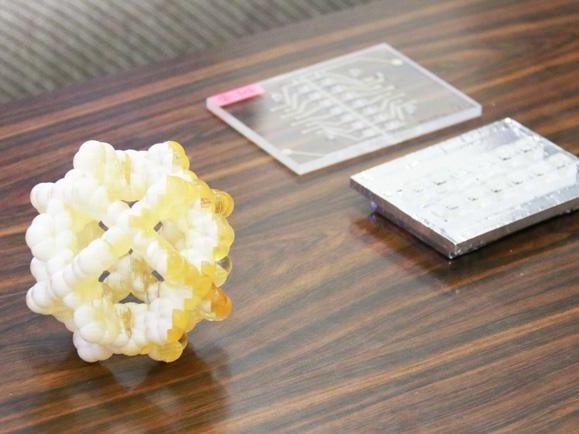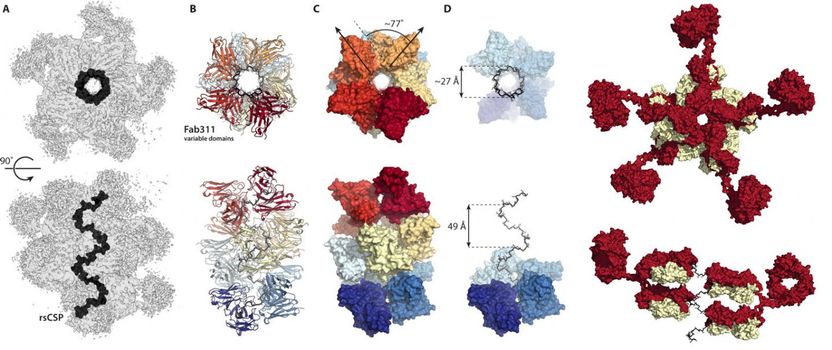One synthetic molecule, two doorways into cell
Shuhei Furukawa from Kyoto University's Institute for Integrated Cell-Material Sciences (iCeMS) and colleagues in Japan synthesised polyhedral-shaped porous molecules that rotate in a double layer of lipids, exposing different-shaped openings. These openings allowed the molecule to conduct ions from one side of the artificial lipid membrane to the other in two distinct ways. Chemists had previously synthesised molecules that conduct ions across a lipid membrane, but incorporating two different openings into a single molecule remained elusive.

This is a 3-D printed model of the synthesized ion channel (left) and the high-throughput transmembrane electrical recorder that records the ion current that pases through the channels (right).
Kyoto University iCeMS
Ion channels are porous proteins present in the membranes of all living cells. They are responsible for managing the transportation of ions across the cell membrane, creating electrical signals that initiate various cellular processes. Most ion channels have a single opening, but a unique family of channels have two. Researchers would like to have a clearer understanding of how these two-pored channels work and whether they might be implicated in some diseases. Designing synthetic channels is one way to go about this.
Furukawa and his team synthesised a molecule made of the chemical element rhodium. The molecule is shaped like a cuboctahedron, with eight triangular and six square faces. The rhodium-based molecule was embedded into a double layer of lipids. The team then synthesized short and long alkoxy chains made of hydrogen, carbon and oxygen molecules, which attached the molecule to the surrounding lipids.
They found that the rhodium-based molecule rotated inside the lipid bilayer, exposing at any one time a smaller triangular- or a larger square-shaped channel. Each shape led to a different state of electrical conductance. The molecule was also found to rotate more slowly when it was attached to the longer alkoxy chains, increasing the amount of time the channel remained open before the molecule continued its rotation.
"Rotational dynamics is the key to switching between distinct conductance states to expose either the triangular or square apertures to the aqueous phase," write the researchers in their study.
The team also found that changing the metal they used from rhodium to copper changed the molecule's permeability: while the rhodium-based molecule is permeable to ions with two positive charges, like calcium, the copper-based molecule only transports ions with a single positive charge, like potassium.
Further studies are underway to improve the molecule's design so the pores are open more often and the molecules can be switched from one state to the other using external stimuli.
Original publication
Ryuji Kawano and Nao Horike and Yuh Hijikata and Mio Kondo and Arnau Carné-Sánchez and Patrick Larpent and Shuya Ikemura and Toshihisa Osaki and Koki Kamiya and Susumu Kitagawa and Shoji Takeuchi and Shuhei Furukawa; "Metal-Organic Cuboctahedra for Synthetic Ion Channels with Multiple Conductance States"; Chem; 2017
Original publication
Ryuji Kawano and Nao Horike and Yuh Hijikata and Mio Kondo and Arnau Carné-Sánchez and Patrick Larpent and Shuya Ikemura and Toshihisa Osaki and Koki Kamiya and Susumu Kitagawa and Shoji Takeuchi and Shuhei Furukawa; "Metal-Organic Cuboctahedra for Synthetic Ion Channels with Multiple Conductance States"; Chem; 2017
Topics
Organizations
Other news from the department science
These products might interest you

Hydrosart® Ultrafilter by Sartorius
Efficient ultrafiltration for biotech and pharma
Maximum flow rates and minimum protein loss with Hydrosart® membranes

Hydrosart® Microfilter by Sartorius
Hydrophilic microfilters for bioprocesses
Minimal protein adsorption and high flow rates

Sartobind® Rapid A by Sartorius
Efficient chromatography with disposable membranes
Increase productivity and reduce costs with fast cycle times

Sartopore® Platinum by Sartorius
Efficient filtration with minimal protein adsorption
Reduces rinsing volume by 95 % and offers 1 m² filtration area per 10"

Polyethersulfone Ultrafilter by Sartorius
Reliable filtration with PESU membranes
Perfect for biotechnology and pharmaceuticals, withstands sterilisation and high temperatures

Polyethersulfone Microfilter by Sartorius
Biotechnological filtration made easy
Highly stable 0.1 µm PESU membranes for maximum efficiency

Get the life science industry in your inbox
By submitting this form you agree that LUMITOS AG will send you the newsletter(s) selected above by email. Your data will not be passed on to third parties. Your data will be stored and processed in accordance with our data protection regulations. LUMITOS may contact you by email for the purpose of advertising or market and opinion surveys. You can revoke your consent at any time without giving reasons to LUMITOS AG, Ernst-Augustin-Str. 2, 12489 Berlin, Germany or by e-mail at revoke@lumitos.com with effect for the future. In addition, each email contains a link to unsubscribe from the corresponding newsletter.
More news from our other portals
Last viewed contents
Scientists create new enzymes for biofuel production

What's that smell? New gut microbe produces smelly toxic gas but protects against pathogens - Taurine-degrading bacteria influence intestinal microbiome

Images of antibodies working together against malaria
Bartonellosis

Evonik invests in start-ups - Evonik More Than Doubles Venture Capital to Accelerate Innovation
Clathrin
Karus Therapeutics Commences Preclinical Development of Novel Immune and Inflammation Programmes
First comprehensive survey of gut, mouth and arterial bacteria finds links to heart disease

How Colon Cancer Hides from the Immune System - Researchers Identify New Targets for Immunotherapy in Colon Cancer
Olink Bioscience and Multisciences Biotech sign distributorship agreement for the Chinese market.





















































